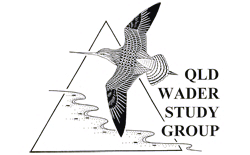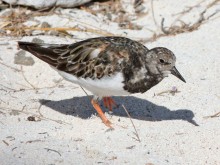Arenaria interpres
Subspecies
A. i. interpres
A. i. morinella
Other Names
Turnstone, Eastern Turnstone, Sea-dotterel, Calico-bird, Beachbird.
Identification
Stocky, short-legged wader with short up-turned bill.
Plumage
Non-breeding: The upperparts are dark brown, with the edges of the feathers being a paler brown giving a mottled appearance. The head, throat and neck are brown. The breast shows a black bib, thinning in the mid-line. The rest of the underparts are white. The bill is black, short and slightly upturned. The legs and feet are bright orange.
Breeding: Male: A bold black and white patterned head. The head is mainly white, though the crown is streaked with black, there is a black band around the eyes joining across the forehead. Also there is a band from the ear coverts to under the chin where it meets a broad black band that extends from the chin and throat to the breast. The back is mottled black and bright chestnut. The rest of the underparts are white. The legs are bright orange.
Female: Similar to the male but duller. The head pattern is less bold and the crown more streaked.
Juvenile: Similar to the adult non-breeding plumage but duller.
Distribution
Found all around the Australian coast particularly where the shores are rocky, shingle or gravel. Will be found away from these areas including mudflats.
Migratory habits
Arrives in Australia in August and September and progresses down the coasts to the southern states. It leaves our shores in March and April. Some birds stay in the north over the winter months.
Breeding
Breeds circum-polar of the Arctic and around the Scandinavian peninsula. Usually not far from the shore using a scrape in gravel or shingle.
Status
The estimated population for Australia is about 14,000 birds.
East Asian-Australasian Flyway Population: about 31,000
Confusing Species
None.

